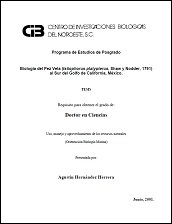Coeficientes de utilización digestiva aparente de materia seca, proteína y aminoácidos esenciales de ingredientes terrestres para el camarón del Pacífico Litopenaeus vannamei (Decapoda: Penaeidae)
Apparent digestion coefficients for dry matter, protein and essential amino acids in terrestrial ingredients for Pacific shrimp Litopenaeus vannamei (Decapoda: Penaeidae)
Autor
MARTÍN MANUEL TERRAZAS FIERRO
ROBERTO CIVERA CERECEDO
Lilia Isabel Ibarra Martínez
ERNESTO GOYTORTUA BORES
Metadatos
Mostrar el registro completo del ítemResumen
"Protein quality mainly depends on the essential amino acid (EAA) profile, but also on its bioavailability, because EAA digestibility is generally lower than the analyzed amounts. This information is needed in the aquaculture industry for aquafeed formulation. For this purpose, the apparent digestibility coefficients of dry matter, protein, and essential amino acids of eight feedstuffs of terrestrial origin were determined for the juvenile whiteleg shrimp Litopenaeus vannamei (15-19g), using 1% chromic oxide as an inert marker. A reference diet was formulated and produced in the laboratory. Eight experimental diets were prepared each with 30% of one of the experimental ingredients added to the reference diet: casein, porcine byproduct meal poultry byproduct meal, corn meal, wheat gluten meal, soybean paste, sorghum meal, and wheat meal. The experiment consisted of a single-factor, completely randomized design with three replicates per treatment. Samples of ingredients, diets and feces were analyzed for nitrogen and amino acids. For amino acid assay, we used reverse-phase high performance liquid chromatography. To avoid partial loss of methionine and cystine, samples of ingredients, diets, and feces were oxidized with performic acid to methionine sulfone and cysteic acid prior to acid hydrolysis. The apparent dry matter and protein digestive utilization coefficients varied from 68% to 109% and from 70% to 103%, respectively. Apparent digestibility of protein for casein, soy paste, wheat meal and wheat gluten were very high (over 90%), corn gluten and poultry byproducts meal showed high protein digestibility (over 80%), but porcine byproducts meal and sorghum meal had low digestibility (76% and 70%, respectively). There was a reasonable, but not total, correspondence between apparent protein digestibility and average essential amino acid digestibility coefficients, except for arginine in corn gluten, phenylalanine and leucine in sorghum meal, phenylalanine in soy paste and lysine in wheat meal and poultry by-product meal. The most digestible feed ingredients for whiteleg shrimp were: wheat gluten, wheat meal and soy paste; poultry byproduct meal and corn gluten were less digestible and the lowest digestibility occurred in porcine byproduct meal and sorghum meal. Feedstuffs exhibited great variability in dry matter, protein and amino acid digestive utilization coefficients, which should be considered when formulating shrimp feeds." "Los aminoácidos esenciales y su disponibilidad son importantes en la formulación de alimentos. La digestibilidad de materia seca (DAMS), proteína (DAP) y aminoácidos esenciales (DAAA) fueron determinados (triplicado) para el camarón blanco del Pacífico, Litopenaeus vannamei (15-19g), usando una dieta de referencia con 30% (de cada ingrediente). Los ingredientes evaluados fueron: caseína (CAS), harinas de subproductos avícolas (HSPA) y porcícolas (HSPP), gluten de maíz (GLM) y trigo (GLT), pasta de soya (PS), harinas de sorgo (HS) y trigo (HT). La DAMS y DAP variaron entre 68%-109% y 70%-103%, respectivamente. La DAP en CAS, PS, HT y GLT fue mayor al 90%, en GLM y HSPA superior a 80%; HSPP (76%) y HS (70%) tuvieron menor digestibilidad. Hubo concordancia entre DAP y DAAA, excepto para Arg en GLM, Fen y Leu en HS, Fen en PS y Lis en HT y HSPA. Se encontró una gran variabilidad en la DAMS, DAP y DAAA en los ingredientes, lo que debe ser tomado en cuenta al formular alimentos para camarón. "
Colecciones
Ítems relacionados
Mostrando ítems relacionados por Título, autor o materia.
-
PROMOCIÓN DEL PERIFITON PARA EL CULTIVO DE CAMARÓN BLANCO: HACIA UNA ACUICULTURA ECOLÓGICA
DOMENICO VOLTOLINA LOBINA; JUAN MANUEL AUDELO NARANJO; MARIA DEL ROSARIO PACHECO MARGES -
Suelo y Erosión
YOLANDA LOURDES MAYA DELGADO


